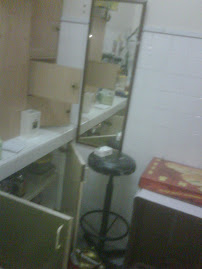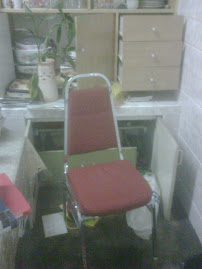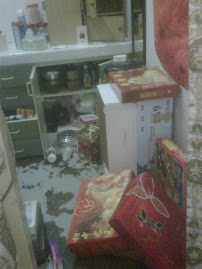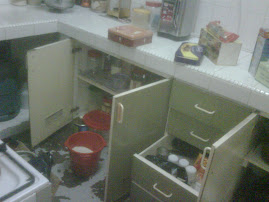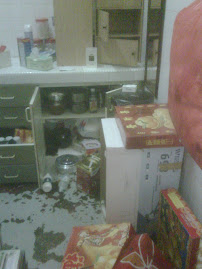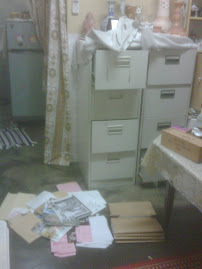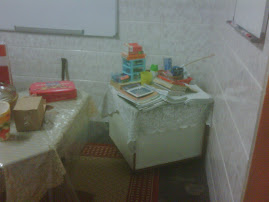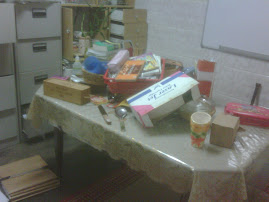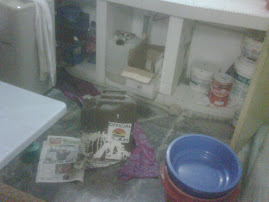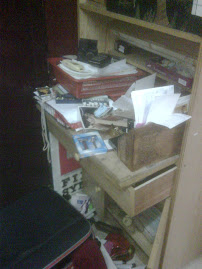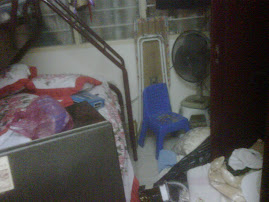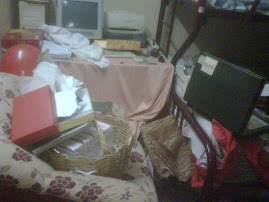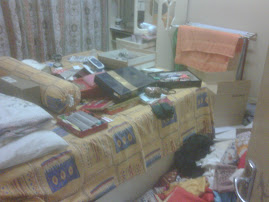Monday, August 16, 2010
50 REASONS WHY IT WILL BE DIFFICULT FOR BN TO SECURE A CONVINCING VICTORY
Wednesday, May 19, 2010
‘Project Sunshine’ changes life in the longhouse


A longhouse resident (pic above) making an international call from
The solar installation on the far right (pic below) on a hillock overlookingthe Kerapa Spak longhouse (left)
IBC COMPLETES SOLAR HYBRID SYSTEM IN
KERAPA SPAK, BETONG
The system dubbed SHS (solar hybrid system) was installed at a feverish pace over a period of four months by IBC Solar Teknik Sdn Bhd, the main contractors who are in a joint technical co-operation with Sarawak based Carbon Capital Corporation Sdn Bhd.
The German based technology, reputed to be the best technology in the solar industry was realised in Kerapa Spak at a cost of RM4.5 million – a cost which is protected by its quality and durability.
The IBC system complies with Europe’s IEC 616 standards wherein power output is guaranteed for 25 years – a definition which spells out the fact that capability does not drop more than 80 per cent failing which the supplier would have to replace the product.
These are the IEC standards upheld by IBC when they did their installation at Kerapa Spak which would have far–reaching effects on the capabilities of the longhouse folk in this particular locality.
The Chief Exectuive Officer of IBC Solar Teknik Ahmad Nazri Ibrahim said that in addition to the lighting -up of the longhouse, the surrounding area’s street lighting, the community area and church have also been lighted up.
“With power comes everything else and among the possibilities that have already made its mark is the pre-paid satellite uplinked telephony system,” he said.
“Longhouse folk are now practically queueing daily up to use the pay phone as they can call anywhere in the world and it will be a matter of time before they join the cyber world with internet access and broadband capabilities besides installing Astro TV.”
Nazri has his reasons for selecting Sarawak and as he puts it, “It is my conscientious belief that after more than 45 years of independence with Malaysia, our brother and sisters in the remote interiors of Sarawak and Sabah are somewhat detached and isolated from mainstream infrastructure development.”
“How are they to develop if they keep on living in such isolation occurring naturally or by design, I wonder.
“They still have no power, limited power in most places, no clean and piped water, no digital information super highway vide the internet and in my honest view, this is completely unacceptable if you see it against the background of a nation trying to scramble for a developed nation status.”
The installation at Kerapa Spak features the construction of a solar house, putting up of the solar modules, inverter, load and battery banks which take up to 40 per cent of the cost. Work was also hampered by the accessibility as most of the things had to be taken up river on five to six-hour longboat rides from Pengkalan in Betong.
The irony however was that despite this being a corporate social responsibility CSR) of IBC with absolutely no cost to the State or Federal governments, there was no other form assistance extended to them from agencies or even the Royal Malaysian Air Force (RMAF) which flatly refused to airlift the equipment citing cost as a reason. IBC had to resort to using costly private helicopter charters to airlift the heavy components.
There is no road access to this longhouse as everything is dependent on the river and the nightmarish work of bringing equipment up will long live in the memories of the team of engineers and technicians who put up installation together.
This added to other logistical frustrations which were encountered by the IBC team over the last four months specially in getting construction material organised in the thick of the jungles.
By no measure was it an easy task for IBC Solar from leveling a jungle clearing ona nearby hillock to forming a clearing and a helipad and making concrete bricks to name a few tasks that were achieved.
The solar hybrid system, according to Nazri is guaranteed to be safe with no possibility of its products either exploding or igniting a fire and with no moving parts, there is less maintenance, noise and above all being environment-friendly.
Being AC coupling in character, the system comprises a 70 per cent solar and a 30 per cent diesel generator back up and is designed to last for 25 years thus ensuring a clean and friendly environment.
IBC, said Nazri, would not be maintaining this CSR project but nevertheless he added, they were in talks with the State Government to appoint IBC Solar under a normal maintenance contract for a period of two years..
What used to be pitch darkness after diesel-powered generators are shut down to save on cost, is now a thing of the past in Kerapa Spak.
The second phase of this project shall witness the installation of dedicated power points for individual “pintu” which will enable longhouse folk to draw power for their individual household needs to run their hi-fis, refrigerators and other appliances.
“With this comes tapped clean and filtered drinking water with the installation of a membrane pump system powered by the solar hybrid system. A longhouse with power, communication and clean water completes the agenda providing the basic amenities and providing the longhouse folk an opportunity to move forward and engage themselves and their lifestyles in the mainstream of development,” said Ahmad Nazri.
IBC represents one of the best German-based technology partners in the form of IBC Solar AG which boasts the most advanced technology and products besides being the initiator of solar technology and currently spearheading the industry.
In the Kerapa Spak project IBC functions as the main contractor on top of being the system designer and integrator. The peninsular based company is in a joint technical co-operation with Kuching-based Carbon Capital Corporation (CCC) Sdn BHd. The project also involved a telecommunications component which witnessed the active participation of Paycomm Sdn Bhd.
Nazri feels that Project Sunshine would aptly describe what’s happening in Kerapa Spak in the rural electrification scheme (RES) of things.
The Kerapa Spak longhouse was selected by Sarawak Chief Minister Pehin Sri Haji Abdul Taib Mahmud as part of his overall vision to provide cheap and versatile electricity to pockets of settlements in longhouses and villages in the remote interiors of the state.
“Electricity is synonymous with the quality of life, security and growth and a good infrastructure, reliable power generation and independence from raw material imports are all essential for prosperity and satisfaction,” said Ahmad Nazri.
“Kerapa Spak is in that position and is now demonstrating this
“It will be a far cry from the manner in which the Iban longhouse community conducted their lives before.”
The investment, Ahmad Nazri feels, would go a long way in proving that for one the public and private sector can engage by way of policy. This he added comes in tandem with the government’s call for greater policy engagement between the two sectors in working together for the benefit of the people.
This project comes as one of the company’s major corporate social responsibility (CSR) initiatives in Sarawak.
The most noteworthy feature of this solar hybrid system is that in essence, it can not only supply electricity but also support water supply, power up systems for healthcare, ensure security with telecommunications link ups, tourism activities, education and cottage industries in the future.
Ahmad Nazri said the SHS under normal circumstances would require between three to four months to install making it one of the fastest solar applications readily available in the market as proven by the project in Kerapa Spak.
IBC Solar Teknik’s role as a systems integrator, is actually appropriately positioned to customise and tailor-make installations to suit each and every location and their respective peculiarities. This is evidenced in Project Sunshine which has taken shape in Kerapa Spak.
The solar modules and the solar house
A close-up of the solar modules which are powering up the Kerapa Spak longhouse.
Longhouse folk in the ruai area of the longhouse with the lights already switched on in the evening.
The site of the solar and solar modules when construction began four months ago.
Construction material at site when work commenced in November 2009
River bed rocks practically carried up from using boats and manpower in gunny sacks to form the bedding base for the solar modules.
The site in March 2010
A helicopter used to bring up the heavy equipment about to land in a clearing made as a helipad
next to the solar house and modules.
Equipment practically made it by air from German and Kuala Lumpur to Kuching and then by road to Betong and on loangboats to Kerapa Spak.
Netting being prepared to airlift the battery banks by private helicopter charter from Betong to Kerapak Spak
An aerial view of the IBC solar installation (right) and the Kerapa Spak longhouse on the left.
The Kerapa Spak longhouse lighted up at nightwith solar power.
Monday, April 19, 2010
Journey upriver to Kerapa Spak
1. Breakfast in Betong town, four hours by road from Kuching city. This town only wakes up at about 7am or so.
2. This location is Pengkala Kerapa on the Nanga Spak. We board the longboat from this point some 40 minutes from Betong town. The boat ride can cost anything from RM380 to RM600 one way.
3. The journey is about to begin. Our destination is Kerapa Spak longhouse. The journey is expected to take about four to five hours.
4. The longboat can seat a maximum of six persons excluding the boatman who steers the outboard engine from the rear and his navigator who sits right up front.

5.The journey is quite smooth sailing except for very shallow stretches where the boatman has to get off and push the boat through and at stretches where he has to force his boat through resuolting in snapping his propellers. They come prepared to change parts along the way.
7. You might have to get down help push the boat across some really shallow patches along the way.
9. At the longhouse in Kerapa Spak.. after five hours.
Project Sunshine nears completion
The Kerapak Spak longhouse community of some 500 Iban folk nestled in the Betong Dvision of Sarawak, will soon become a centre of attraction when IBC Solar Teknik Sdn Bhd is done installing their Solar Hybrid System which is expected to provide long awaited electricity supply, drinking water and a telecommunications link. This project is being donated by IBC Solar as part of their corporate social responsibility inspired by the call made by Sarawak Chief Minister Pehin Sri Haji Abdul Taib Mahmud in extending rural electrification to the interiors. The project is valued at one million euros (RM4.5 million). Work on this project which began in November last year is expected to be completed next month. The longhouse is now seen in clear view of the solar house which is already up with other works progressing full steam ahead. The project is currently about 85 per cent complete and is expected to be handed over in mid May by the Prime Minister Datuk Seri Najib Tun Razak.
LAWLESSNESS IN MALAYSIA
When driving in the roads and streets of downtown Kuala Lumpur, you have to get used to this sort of crappy driving by Rapid KL buses. What's the point having expensive buses dirven by morons who are ignorant of simple road discipline. They appear to make everyone in the bus a stupid lot having to tolerant such nonsense by the driver. To RAPID KL and Prasarana... the bus service is akin to the days of teh hell driving mini-buses. We haven't learnt and we haven't improved. Low class public transportation behaviour, I must say.

Sunday, April 18, 2010
Project Sunshine tipped to change life in the longhouse


IBC’S SOLAR HYBRID SYSTEM MAKES IT TO KERAPA SPAK, BETONG
KUCHING (March 24, 2010): Life will not be the same for the Iban community of 500 folks staying in an isolated longhouse nestled in the interiors of Sarawak Betong Division as they will be the fortunate ones to enjoy a solar hybrid system.
The system dubbed SHS is being installed at a feverish pace at the longhouse by IBC Solar Teknik Sdn Bhd the main contractors of what is a reputed the first of its kind undertaking to provide not only cheap, lasting and versatile supply of electricity but with it comes clean drinking water and a telecommunications uplink which will see the onset of internet and cable TV making its way into the 43 ‘pintu’ or doors of this longhouse.
What used to be pitch darkness after diesel-powered generators are shut down to save on cost will soon not only be a night of brightness but complete with hi-fi music, Astro TV, internet surfing and phone calls to any part of the world. Tapped drinking water too coming with these, makes the SHS a flagship undertaking which would be very much in line with the government’s move to expand rural electrification to the hard interiors of Sarawak.
IBC represents one of the best German-based technology partners in the form of IBC Solar AG which boasts the most advanced technology and products besides being the initiator of solar technology and currently spearheading the industry.
In the Kerapa Spak project functions as the main contractor besides being the system designer and integrator as it also involves a telecommunications component that sees the participation of Paycomm Sdn Bhd.
IBS Solar Teknik’s Chief Executive Officer Ahmad Nazri Ibrahim feels that Project Sunshine would aptly describe what’s happening in Kerapa Spak in the rural electrification scheme.
The Kerapa Spak longhouse was selected by Sarawak Chief Minister Pehin Sri Haji Abdul Taib Mahmud as part of his overall vision to provide cheap and versatile electricity to pockets of settlements in longhouses and villages in the remote interiors of the state.
Illustrating the nature in which the solar hybrid system would be working, Nazri explained that the DC current generated by the solar modules would either be used immediately for water pump systems, general lighting, telecommunications and for use by appliances or it would be stored in batteries.
“Electricity is synonymous with the quality of life, security and growth and a good infrastructure, reliable power generation and independence from raw material imports are all essential for prosperity and satisfaction, says Nazri.
“Kerapa Spak would be in the best position to demonstrate this once the installation is complete towards the later part of April, this year.
“It will be a far from the manner in which the Iban longhouse community conduct their lives today.”
The project estimated is going to cost IBC Solar Teknik a whopping RM4.5 million (one million euros). To this, NAzri quipped, “We have to break the egg’s shell first in order to eat it. SO how can we be sorry for breaking the shell.” The company has to date spent RM3 million securing 70 per cent progress in its works.
It has also not been for the working crew of IBC at Kerapa Spak. The longhouse folk, he said had been quite helpful and we have engaged them in toto to perform a major part of the construction work .
All material, he added, had to be brought in through a treacherous six-hour long boat ride from Pengkalan near Betong which is a four-hour drive from Kuching. This included sand, stones, gravel and timber in addition to the hardware. Work at kerapa Spak started in November 2009 following a memorandum of understanding between the State Ministry of Public Utilities and Carbon Capital Corporation (CCC) to carry out solar hybrid projects in the state in June last year. CCC is working in collaboration with IBC Solar Teknik as the main contractor of the former.
Other logistical support comes airlifts provided by the Royal Malaysian Air Force (RMAF) based in Kuching.
The investment, Nazri feels would go a long way in proving that for one the public and private sector can engage by way of policy. This he added comes in tandem with the government’s call for greater policy engagement between the two sectors in working together for the benefit of the rakyat.
This project comes as one of the company’s major corporate social responsibility (CSR) initiatives in Sarawak.
The most noteworthy feature of this solar hybrid system is that in essence it can besides supplying electricity, also support water supply, power up systems for health care, ensure security with telecommunications link ups, tourism activities, education and cottage industries.
Nazri said that the SHS under normal circumstances would require between three to four months to install making it one of the fastest solar applications readily available in the market and IBS Solar Teknik’s role as a systems integrator, is actually appropriately positioned to customise andtailor-make installations to suit each and every location and their respective peculiarities. This is evidenced in Project Sunshine taking shape in Kerapa Spak.
Thursday, March 11, 2010
Placing the chip in the right place to spur New Economic Model

MALAYSIA has all it takes to make that quantum leap into becoming a high-income nation. The New Economic Model (NEM) will be a monumental task for Malaysia in steering its workforce in the direction most desired in achieving such an economic model.
But is the government prepared to make a departure from its conventional approach of having to rely quite heavily on foreign experts to consult for work to be done.
Do we not have what it takes to provide such expertise and do we not have what it takes to carry from where many had left.
The NEM to be proposed by the Prime Minister Datuk Seri Najib Tun Razak towards the end of this month will focus on raising the productivity level of workers and helping them earn higher income.
This task is expected to be handled by a new economic council comprising experts both from within Malaysia as well as from aboard.
The model would undoubtedly outline how Malaysia is going to improve its economic situation from the high middle income level where it is positioned currently to a high income level.
The quantum leap desired by way of increase in workers’ productivity should not only be more hours worked but it also has to harness innovation and creativity.
By achieving this, the workforce will be paid higher salaries. With the NEM in place, all efforts be they those involving the private sector, government-linked companies (GLCs) or even government companies can in a parallel move, raise workers’ skills through such innovation and creativity to ultimately bring progress to the nation.
The NEM therefore has to be carved, chipped, smoothened and scupltured in such a way so that it can be beneficial to workers within the country being able to attain a higher level of competitiveness.
The government's goal is to enable the country to make a quantum leap and efforts must be taken to translate the noble desire of the government to translate such efforts into a reality.
The current rate of unemployment in the country is about 3.1 percent in 2009 and could increase to four per cent this year due to impact of the global economic recession, a situation which has to be addressed as the NEM is being formulated so that the jobless are employed and the rate of unemployment kept in check.
The NEM would indeed have to lay the groundwork now to develop the required pool of talent ready to take on such a big challenge.
SKALI’s contribution as a major player in the MultiMedia Super Corridor (MSC) for one, thus far has seen the company creating job opportunities and technopreneurs via the execution of the managed portal services (MPS) project.
Timely too is the 1Malaysia concept launched by the Prime Minister which is expected to draw on the strengths of a united population with leaders seeing and visualising this together.
A campaign of this magnitude requires strength in unity, selfless hardwork and the magnanimity of helping others to come onboard and be engaged in the process of change and transformation.
But in order for the policy to gain ground, there will be need for a wider participation and engagement by captains of industry and political leaders alike to be in sync with the Prime Minister in wanting to move this forward.
But not forgoing the fact that these are transformations being attempted during trying times of a global economic recession and countries such as Japan and The Netherlands in fine tuning their policy moves and practices should lend us a hand in taking the cue to better protect ourselves from volatility.
A common group is therefore sought where they can work together in overcoming obstacles and facing up to challenges which they might encounter in its implementation.
Before one knows it, the decade will be up and we are staring 2020 right in the eye and expect the middle spectrum of the visionary management spelt out by its conceptualiser to materialise and unfold Malaysia as a newly developed nation carrying a label that has to read “yes we can.”
The catch phrase could have worked wonders for Barrack Obama in his socio-political economic reform of the United States but it had better not be a phrase which we find difficult to live up to if old mindsets are not changed.
There is no room and there will be no patience in tolerating those out to make a quick buck for themselves by taking advantage of the privileges that are expected to be handed out as the NEM takes shape.
There will also be no slowing down in dealing with petty and trivial issues that could crop up along the way as the mode of engagement would be look at the bigger picture and be involved in the macro-economics of such governance.
Encouraging and promoting local business talent from whom a number of them had even broken barriers and taken that Malaysian brand name across the globe.
When such business icons are unearthed, Malaysia will emerge in a new dimension of being an an active seller as opposed to being a tradional buyer in the past. Names in the league of Air Asia, Maxis, Axiata, Sime Darby, Astro, YTL to name a few have forced decision makers to sit up and take notice that going Malaysian is by all means being Malaysian and warrants recognition from the government especially in having to be assigned such tasks.
To develop such icons, the government needs to provide them a platform so that they are able innovate their business ventures and take them to the next level by providing incentives and the marketing needed to accelerate their growth to achieve the desired results.
The government too needs to break away from its conventional modus operandi of mostly engaging with foreign consultants to undertake jobs which could otherwise be handled by homegrown Malaysian expertise and talent.
If such opportunities are not given to locals, they will never be tried and tested to emerge as lead players in critical areas of development projects.
The underlying message would be of course to tap on local talent and given them an active role to play in the NEM and by 2020, Malaysian professionals in their late 20s would be in their fourties with the right maturity and experience to become active players and take over agencies to administer and manage them more effectively with new management modes and techniques of changing times.
Skali has managed to do this over the years and have fully harnessed the talent inherent in fresh local graduates who were made to be involved in the management of portal services given their disciplines in the fields of information and creative technology.
However, the success of the NEM given the current scenario will only be able to germinate if it is led professionally and enriched with the concerted efforts of those entrusted to play a vital role in its implementation.
HISTORY TAKES SHAPE AT IBC’s SOLAR LONGHOUSE

It was hardly eight months ago when peninsular-based IBC Solar Teknik Sdn Bhd announced that it would be donating a one-million euros (RM4.5million) solar hybrid system (SHS) to practically light up the 43-door Kerapa Spak longhouse.
IBC Solar’s chief executive officer Ahmad Nazri Ibrahim in a statement released here today said the project had made tremendous progress and was scheduled for completion and commissioning in about a month.
The project, he said , was about 60 per cent complete and that everything was in place for work to proceed as scheduled in realising a mission which would have a large impact on the prospects of a solar hybrid system complementing the existing grid system in the state.
The SHS, he said, worked hand in hand with the on-grid system to provide electricity to the population nestled in the interiors of Sarawak and that it had a long term cost advantage whilst being easier to maintain.
“These systems are usually installed in remote areas with no road access and the communities there need to take care of the systems and carry out the necessary routine inspections and our SHS had met the requirements enabling such communities to use the SHS with ease.
The SHS which boasts low maintenance and an easy operating system seems to be the perfect answer especially to the needs of the longhouses in the interiors of Sarawak.
The Kerapa Spak longhouse has a population of 250-odd folk whose main livelihood comes from smallholdings growing pepper, rubber and hill padi.
The SHS features water supply system offering filtered drinking water from available natural water sources as well as a telecommunications linkage with internet access no longer being a impossibility.
The federal government has also, as part of its National Key Result Areas (NKRAs) set its eyes to focus on speeding up infrastructure development projects in rural Sabah and Sarawak, said Nazri.
More than RM1.6 billion from that allocation would be for water supply projects including water treatment plants. These are to be implemented by the year 2012 while the remaining more than RM1.7 billion will be for rural electricity supply projects. This includes grid and non-grid (systems)
IBC Solar is in a technical collaboration with Sarawak-based Carbon Capital Corporation (CCC) Sdn Bhd had signed up with the State Government for the design and building of the first SAH in Sarawak in June last year.
The company is backed by superior German technology – the initiators of the solar technology and who are currently spearheading the industry at a global level offering advanced technology and products.
Nazri added that Malaysia was the first country to promote and use first world Green technology (greentech) and IBC Solar’s SHS is evidence of such a move in the right direction.
The use of greentech for electricity generation, said Nazri is gaining recognition both locally and especially internationally. The government, he added, had also formulated strategies to promote it in all sectors in order to conserve the natural environment and resources through the application of environment-friendly technology, especially in electricity generation.
Sunday, February 21, 2010
DON'T TRUST THE POLICE




YOU make plans to leave home for a couple of days and what do you do? You heed the call being made by the police time and again and inform the nearest police station. The record your details of departure and arrival and contact numbers and what happens when you come back in four days time?
Your house is burgled, ransacked and you are relieved of whatever cash and jewellery you had stashed away discreetly in your house.
Your privacy as been encroached, you feel intruded, your life had turned into a nightmare from what was to have been a joyful break.
Why?
1. The stupid policeman in the station can actually say that they cannot keep watch on your house 24 hours a day.
2. They say they are understaffed and only have three personell in that station.I ask myself then why bother opening a police station to give a false impression of a police presence in the area.
3. You are definitely not safe in your country.
4. I know for a fact that as a Malaysian, I am not safe in my country, in my neighbourhood, in my streets, anywhere for that matter.
5. What's the police for. To set up roadblocks and talk to motorists in the dark I guess.
6. Who's to blame? The police of course.
7. Were the neighbours alert? What neighbours? They only know how to say "Tak Tahu" and complain about your chiku tree encroaching in their space.
So what do we do?
1. DOn't inform the police.
2. HAve an alarm system only as a deterrent. Chances are the police would be too understaffed to respond.
3. Rear a dog. It too can be poisoned.
I hope the intruders who ransacked my home and robbed me rot in hell with the police in tow.
DON'T TRUST THE POLICE
You make plans to go on a trip for a couple of days especially during a festive break. So what do you do to secure your home.
You heed the call being made by the police every now and them to inform the nearest police station of your whereabouts, date of departure and date of arrival plus your contact no. Thinking that all would be well, you do just that.
You walk into the Taman Segar police station a day before you leave the house. They record the details and say "we will patrol the area".
Fours days later when you come back you find the front grilled gate open with the locks broken, door broken into and the house ransacked from front to back. The worst nightmare has just began.
You call 999 and you get connected with the police and when you do a stupid policemen says that you have to go to the nearest police station and lodge a poilice report.
So i tell this stupid policeman that my wife is frantic and traumatised to see the house which can no longer be secured but the stupid policeman insists.He advised us not to touch anything.
So we drive to the Taman Segar police station and another stupid policeman starts keying in the report and asks us what was missing. So we tell that stupid policeman that we were advised not to touch anything so how did he expect us to know what was missing. So by visually looking at the places which were encroached, weassumed the worse and that was jewellery stashed in very discreet places in the house stolen plus cameras and what have you.
Than the stupid policeman says that I should call the IO (investigating officer ) on my handphone which I did. And the IO whic is based at thePudu police station some 6 kilometres away says that I have to go there and sit before him so that he can record a statement. I did just that and told the IO that we were not in the position to come there and by right the police should be coming over. He grumbled and said that he would come.
Meanwhile i vented by frustration about our leave of absence and despite having done that, my house was broken into. They reply was "we cannot be watching your house 24 hours a day." And when we said that nothing happened on instances when we did not inform the police before leaving, the reply was; " We are understaffed. We only have 3 anggota ( staff ) at that particular station." What a load of crapp. If the stupid police force does not have enough cops , why bother having a police station to fool people that there is a useless police presence in your area?
The stupid policeman in the balai advises us that we go home and stay put and he will be coming over in a patrol car immediately to investigate .
We head home and an hour later the IO arrives. Mind you the immediate reponse team did not turn up as promised. The patrol car came an hour after the IO saying that they had to handle an accident nearby.
The IO starts to ask question and recorded the stuff which we knew for sure which were stolen. They inspect while another office takes pictures and dusted the area for finger prints.
Did you know that the Royal Malaysian Police Force, PDRM for short can only dust prints if there are any on glass or shinny metal surfaces and no where else. Wooden areas and other spots are out.
We lost all the jewellery which were cleverly hidden, my video camera, my Nikon SLR, all the watches and mind you the intruders had the audecity to enter the prayer room and ransack the place to remove jewellery which were kept for use on the deities as well as a bucket of coins which were saved for fulfilling a vow.
They even rancaked my rice container , salt container, dug into my salt lamp, broke a lot of porcelain stuff to name a few of the things which they did.
I impressed upon the IO that they carted away three large containers of 50 sen coins which were collected over the years by wife and something which was not easy to lift. A clue I said was that if someone attempted to cash in such a large amount of coins, your would get a lead. A blank look came from the IO.
After having done all that, they proceed to question the neighbours after giving a long lecture on why we sould not use Solex or Solex type locks as they could be undone with a sharp allan key type of tool.
They ask if there is an alarm system or a CCTV, both of which I do not have as I am not rich let alone famous but just an average Malaysian staying a typical housing estate type single storey terrace house, wanting to be safe in my own country.
The neighbourliness in KL sucks big time. You have neighbours who only know how to complain about your encroaching chiku tree, dried leaves which theyt have to clear and they even threaten to cut the tree which provides shade and fruits.
With all the commotion of intruders undoing your front gate locks and ransacking your house, breaking stuff, all they can say in "tak tahu" . Yes, they are Chinese. They even refuse to come out when the police were calling on them. A neighbour in front who is known to be the nosy one in the street says that he was not aroudn and did not see anything. His equally nosy wife was more interested to know what we lost . The stupid police team were actually condeming the Solex locks, cracking jokes and laughing rather than investigating. Another neighbour who we know for a fact never left home for kampung, told the police that they just came back minutes ago while the wife was seen collecting the dried clothes from outside.
So much for couldn't care less KL neighbours, Chinese in particular whose favourite reply is "tak tahu".
That was the end of the matter and the so called investigation by the stupid police of Cheras.
They managed to get 10 clear prints an God knows what will come out of it. The IO asked if we could identify our jewellery and "of course" we said.
The stupid police of Taman Segar police station asked us to come over again to the station to file in a "report tambahan" to which I said a detailed full blown statement had just been recorded plus photos taken and drawings done and I did not see the need for the "report tambahan".Oh , I almost forgot. They asked us why we did not "bela anjing".
SO what's the moral of the story?
1. Don't inform the stupid police when you leave town.
2. The police are not professional in handling crime victims.
3. Malaysians are not safe in their own country.
4. The police are a lot better in setting up road blocks and talking to motorists in the dark.
5. Burglars are ruthless and they know where to dig these days.
6. Don't trust the police.
7. As a Malaysian, you are not safe in your country.
8. Don't trust your neighbours.
9. No point being neighbourly.
For the record, my police report number is CHERAS/003647/10 dated 20/02/10 made in Taman Segar Police Station
May the burglars rot in hell with the police in tow.
Wednesday, February 3, 2010
HO HUP EGM RESTRAINED BY HIGH COURT
The injuction was taken out by Extreme Systems Sdn Bhd which is a major shareholder holding 27 per cent stake in the PN17 status company currently plagued by a tussle for management control.
The EGM was called for by Datuk Low Tuck Choy who also acts for Low Chee & Sons the company founded by Low Chee who is also the founder of Ho Hup. Low Chee & Sons control 23 per cent stake in the company and is represented by Datuk Low’s sibling Low Teik Kien in the present borad of directors.
This morning’s meeting which was to have convened at the Sime Darby Convention Centre in Bukit Kiara here, saw a trickle of shareholders turning up only to be notified by Ho Hup’s secretarial registration staff manning the venue that the EGM had been halted by way of a court order.
The meeting was to have covened at 10 am. Shortly before that, the lawyers for Extreme Systems Sdn Bhd William Leong & Co represented byits lead counsel William Leong Jee Keen turned up to served the restraining order.
The order was served on a registration staff at the entrance of the convention hall after being notified that the shareholders meeting had been restrained by the Kuala Lumpur High Court.
Shortly after, the LED venue display at the entrance to the convention hall read CXL ( cancelled). Mr William Leong went on to relay the contents of the restraining order to members of the media present.
He said the hearing was conducted over two days from Tuesday afternoon and the order was meted out by Judge Mah Weng Kwai in Chambers last night.
The restraining order was to pave the way for pending suit by Extreme Systems against the defendants which constitute Ho Hup Contruction Bhd and 28 others.
As such the order prevents Ho Hup Construction Berhad, former managing director Datuk Low Tuck Choy who holds 3 per cent share via Low Chee & Sons which holds 23 per cent and individual shareholder Choo Soo Har who holds 2 per cent share and 19 other minority shareholders from conveneing the EGM.
THE EGM was intended to vote out the present board of directors and appoint a board selected by Datuk Low . The directors named to be voted out ars Executive Vice Chairman Datuk Vincent Lye ( who owns Extreme Systems), the present managing director Lim Chong Choy, Dato Liew Lee Leong, Lai moo Chan, Longf MD Nor Amran Long Ibrahim, Modh Shahril Tan Sri Hamzah and Foo Ton Hin. The only board member whom the conveners plan to retainwas Low Teik Kien.
The EGM was convened in an attempt to vote in Tan Sri Kamarulzaman Shariff who is also director of Magna Prima Sdn Bhd, Hew Chin Tay, Yusob Md Tasir, D. Felix Dorairaj, Haji Slamat Hamzah and Chow Seck Kai.
An oral application for a stay of the restraining order by counsel Mr Rabindra Nathan who represented shareholders Datuk Low Tuck Choy , Chan Bee Ling, Low Lai Yong , APT Avenue Sdn Bhd and Tung Yin Peng was dismissed with costs.
Extreme Systems was represented by councel S. Suhendran.
Both Datuk Low as well as Datuk Vincent nor any other board member was present this monring at the venue.
Ends.
Tuesday, February 2, 2010
SILVER CHARIOT DAMAGED
Shame in a chariot mishap
The majestic silver chariot carrying the gold and jewel decked deities of Lord Muruga and his two consorts is an annual affairs which attract close to 100,000 devotees in the 14 hour procession from the Sri Maha Mariamman Temple in Jalan Tun H.S.Lee on the eve of the festival.
The religious procession is by far the largest in the country and attracts tourists as well as prompts engagement with the not only the Indian community but also the Chinese community who come forward to make offering, put up tents to serve free food and drinks to the devotees in the procession as well as those who take vows to carry kavadis or milk pots in that 15 kilometre journey while others chose to smash coconuts in the path of the chariot.
The silver chariot holds many interpretations as to its sanctity, it significance to life and mankind. It a divine process and a holy journey which should be capitalised on and its benefits harnessed in every way possible.
This year, without exception, the chariot ran into trouble and I squarely blame the temple authorities for not only understanding the virtues of the chariot albeit the chariot procession and have made it again a public mockery.
In the wee hours of the morning on Friday January 30, the chariot was stalled in Jalan Ipoh a few metres from the Sentul Police station at the overhead pedestrian bridge fronting SK Sentul Utama. Like the bridge in Batu 3 ½ Jalan Ipoh in front of Chung Hwa Independent High School, this bridge is also an electrically operated mechanical hoist type of steel bridge to allow the chariot to pass through.
While all caution is taken by the driver of the motorised vehicle pulling the chariot and the officials who are supposed to be in the know, the chariot could not pass under.
An incapable and amateur temple security boy actually instructed the chariot to proceed notwithstanding as the gold “kalasam” or minaret that forms the apex of the chariot could “bend” without breaking and I was shocked that they actually proceed resulting in the “kalasam” tip snapping. As if they had not done enough damage, three climbed on top of the chariot (an act that is never done when the deity is present inside the chariot) and tried to do all kinds of things to cut, if not hammer down the iron support within the “kalasam”.
Foolishly , a second attempt was made with a broken “kalasam” to pass through and this time the top most tier of the silver chariot was pulled away snapping the silver seams.
It then dawned upon them that the chariot should have been steered far left was the road was at its lowest to allow this towering chariot to pass through and so they did.
With such damage, the gold “kalasam” in pieces and all kinds of patch work done with a garland and a cloth to conceal the “topless” chariot, they proceeded.
The “kalasam” is actually the pride and source of beauty of the entire silver chariot and the main source of incoming universal energy for the deity which had only hours before been awakened and charged in the temple with a special pooja and prayers and mantras of sorts.
I walk with the chariot every year and have done so since I was 12 in 1971 when the chariot was a wooden one and at a time when only a hundred odd devotees would follow the chariot all the way. It is not an easy walk especially when tolerating the scorching sun of the noon heat as the chariot if on its final leg of the journey.
Much has changed since and today, a temple which claims to be the richest in the country has failed yet again to manage a procession which is a pride of the Hindu and Malaysian Indian community in the country.
The list goes on but I must highlight this incident as the chariot was stalled for a good one hour and 15 minutes and one many instances made to be unhooked from the vehicle and worst off reversed. A chariot on the move should never be reversed as its journey symbolises the journey of life which is meant to move forward moving. Now I understand that not only are the temple officials entrusted with such a task ignorant of what they are doing and what it stands for, but they are also intimidating the very responsibility of managing an annual pilgrimage by the deity which brings “life” to Thaipusam.
I personally find the Penang silver chariot journey much better managed although there, George Town comes to a standstill during a much longer 18-hour journey. But being a KLite , I pride myself of being son of KL that attracts the largest number of Indians in a single festival at any one time in the world and that’s Thaipusam in Batu Caves.
Monday, February 1, 2010
TURNING HO HUP AROUND
Datuk created waves in the circle of builders when he bought into Ho Hup in December 2008 through his company Extreme Systems Sdn Bhd.
The best part of tis deal was he had bought into a company which was already a PN17 company with Bursa.
He is now seen as the saviour of the 50-year old Ho Hup turmoiled not only in accumulated losses due to mismanagement but also what has surfaced as a tussle between two groups trying to wrest control of the management.
The EGM scheduled for Feb 4 will decide whether the group led by ousted managing director Low Tuck Choy or the current management team headed by Datuy Lye, will survive and win the shareholders’ confidence which will give them the mandate abd suport needed to get the show on the road for Ho Hup.
Datuk Lye’s 13 months in Ho Hup has not been an easy journey but helping him with the clean up is Lim Ching Choy whom he brought over from Magna Prima where he still holds a small stake.
Ching Choy’s experience with Magna Prima and also his experience in turning around the Mah Sing Group augurs well in his makeover of Ho Hup which has so far pulled the company out of situation of threat to its operations.
One of the most shocking experiences for Datuk Lye was having to go to Madagascar to gace the government there at a time when Ho Hup was locking in intenrational arbitration over a project that was abandoned.
The board authorised Datuk Lye to make the trip in between May and June last year to meet the president of Madagascar Andry Rajoelina to reach a settlement.
Thia was at a time when there was instructions to detain any official of Hop Hup who attempted to enter the African island nation.
A month later an agreement was reached averting a potential liability of USD 43 million (RM150.4 million) and any loss of the plant and machineries which had prior toi that been seized from Ho Hup.
The plant and macineries which had a book value of RM33 million coild be used for future projects not only in Madagascar but also back in Malaysia.
Datuk Lye was not just a chip of the old block and true to his prowess in wheeling and dealing, managed to sign a memorandum of unerstanding between Ho Hup and the Madagascar government to assist their state-owned company - KRAOMA S.A. in the reinforcement and optimisaton.
Next on Datuk Lye’s agenda was to rescue and rehabilitate troubled projects that had been delayed - the most significant of which was the Jalil Sutera property development project.
Ho Hup re-commenced its contruction actiivities in December 2008 and managed to complete it ahead of the deadline given by the Ministry of Housing and Local Government which responded after purchasers had lodged complaints against the company’s hanling of the project.
One other project which had suffered a similar fate were also rescued such as the Phase 4 which was fully completed in January 2009 eight months ahead of schedule and just six weeks after the new managemen team took over.
The handing over of keys to the purchasers was officiated by the then Housing Minister Datuk Seri Ong Ka Chuan.
This was followed by Phase 5 which was completed in June 2009, three months ahead of schedule whereas Phase 6 and Phase 7a were completed a month and three months ahead of scheduled in August 2009 and September 2009 in August and September 2009 respectively.
The subsequent Housing Minister Datuk Seri Kong Cho Ha went on to present the keys to the purchasers and presented a plaque commending Ho Hup for its ability to revive and complete projects.
Ends
THAIPUSAM BLUNDER 1
A strange omen that unidid itself
Did you all know that moments before the main pooja started inside the Sri Mahamariamman Temple in Jalan Tun H.S.Lee , to send of the deities on the chariot journey, a dimwit photographer who was right in in front of the deity tipped over the main silver thirvathaney.
This multi-flame instrument is the first to be lighted and showed in front of the deity whe the curtain is draw and the pooja begins.
The fact is it went rolling (into piece) , oil spilt, thread all over the floor and the worst part is the pandarams put it together except for the top most part which went "missing".
Oh boy! How embarassing. Strangely there was a kind sould in that crow who picked up that silver head piece and returned it to complete the assembly of parts which formed that ornate intrument.
The disgusting however was that the pandaram chose to pick up the wicks which were scattered on the and reused it. I thought they would have better brains than that and I assumed that all things done in a temple sould be clean and pure and sacred if it was for the use of prayers and for poojas or deities whichever the case may be.
The Chinese photographer was terrified and apologised repeatedly and gained the strange looks of those cramming in front of the surging crowd.
What crossed my mind was that it was not a good omen. I may be superstitious but what happened 3 hours later during the chariot journey may shed some light on my initial premonition.
The pooja went on as usual with some crucial mantras left out.
This was past midnight on Jan 29, 2010.
Wednesday, January 27, 2010
THE HO HUP REGULARISATION PLAN AND WHAT IT ACTUALLY MEANS - A 60 PER CENT 'HAIR CUT'
The company is proposing a 60 per cent ‘haircut’ as opposed to the 95 per cent ‘haircut’ proposed earlier on June 24, 2009.
Going by their application to Bursa seeking an extension of three months to submit a revised plan taking into consideration additional factor, its managing director Lim Ching Choy, said the proposed reduction of the existing issued and paid-up share capital of the company by RM0.60 of the par value would result in a share consolidation on the basis of five ordinary shares of RM0.40 each into two shares has also been proposed.
“The present board had also proposed a placement of approximately 10 million news shares at an issue price of RM1.00 each and the identities of the placees will be disclosed to shareholders together with a full announcement on the proposed revised scheme, said Lim a statement released today.
The scheme will also see a proposed renounceable rights issue of up to approximately 30 million new shares at an issue price of RM1.00 per revised rights share.
“We are protecting the interests of minority shareholders and we know for a fact that they have been with this company for a long time and appreciate their loyalty and faith in the Ho Hup branding,” added Lim in an apparent response to a reaction by former managing director Dato Low Tuck Choy who was reported saying that he believed that what the current management was proposing was not in the best interests of minority shareholders.
Tuck Choy, through his family’s Low Chee & Sons Sdn Bhd’s holding and other direct stakes, controls about 27% of Ho Hup shares.
He had called for an EGM on Feb 4 to remove seven of eight existing Ho Hup directors, including executive deputy chairman Datuk Vincent Lye and managing director Lim Ching Choy.
Tuck Choy is not offering himself to be re-elected, but had proposed six appointees whom he described as “good, capable and experienced candidates” as replacements.
He said his younger brother, currently Ho Hup non-executive director Low Teik Kein, would remain on board as Low Chee & Sons’ representative.
However Lim said the present state of affairs of Ho Hup was very much due to mismanagement during the tenure of Datuk Low from 1994 till 2008.
“At the time of his exit the share price was at RM0.30 and it was based on that share price that a bigger capital reduction of 95 per cent was initially proposed.
“But the share price had since improved indicating that shareholders have gained confidence in the present management in reviving this 50–year old company that was declared a PN17 company with Bursa in July of 2008.”
Explaining the regularization plan further, Lim said the lower capital reduction this time round comes with the option to leverage on the company’s current 60-acre land bank which they have earmarked to develop Jalil Green City.
This will see a proposed reduction of the existing issued and paid-up share capital of the company by RM0.60 of the par value. A share consolidation on the basis of five ordinary shares of RM0.40 each into two shares has also been proposed.
This would mean that it would either be a 60 per cent capital reduction with the said parameters or a core land bank transaction in the event the proposed revised capital reconstruction is unsuccessful.
This means that the shareholders on Feb 4 will have two options and can vote either vote for the capital reduction or vote for the company to leverage on its core land bank to address the accumulated losses of the Ho Hup Group with certainty in Lim’s plan to bail out Ho Hup.
Lim’s two-pronged approach comes with a back-up plan in which the land bank transaction can be with arrangements to jointly develop the core land bank where the company can either enter into an option to secure buyers for the development projects within the land bank or a combination of the two.
“In essence, the new plan will see a lower amount of restricted shares indicatively to 10 million and a higher quantum of rights shares to indicatively 30 million shares.
Lim also refutes the possibility of a new substantial shareholder coming in with the proposed capital reduction with the rights and shares’ sale and he has clarified that the proposed private placement will be placed to both strategic and non-strategic investors.
“The selection criteria will take into consideration that they must add value to the operations of the Group and this can be done only if the investor understands or is familiar with Ho Hup’s business of property development and construction business and above all the financial viability of the projects.
The surge in the share price was among the key factors that had prompted Lim’s team to rethink their capital reduction footing and deciding on a 60 per cent ‘haircut’ as opposed to the earlier 95 per cent.
Nonetheless Lim continues to be firm with the fact that all the existing shareholders will remain as shareholders, assuming they subscribe, and the details of the proposed private placement will be made known by the board.
Lim has also assured that none of the placees are going to be parties related to the current major shareholders or Ho Hup directors.
On Dato Low’s alternative plan, Lim said that it would not fulfill the basic fundamental requirements for the upliftment of the PN17 status of Ho Hup.
Dato Low had claimed that a regularisation could be done without a capital reduction and had proposed an alternate plan which called for a renounceable one-for-one rights issue of 25.5 million irredeemable convertible preference shares (ICPS) with two warrants for each ICPS subscribed.
Lim said that this was because the amount of funding to be raised (RM25.5 million) is insufficient for Ho Hup’s debt management and working capital especially for the development of the 60 acres.
Moreover Lim feels that there is no guarantee that the free warrants will be exercised in the near future and hence has deemed the cash flow of RM51 million arising from such an exercise, as highly uncertain. This means that with insufficient funding, uncertainties will continue to plague Ho Hup’s continued operations as a growing concern as its current potential renders the company to remain as a PN17 company. This is bearing in mind that the Group had recently secured a loan for RM125 million to refinance its current loan to CIMB and can risk the foreclosure of its land bank in the absence of alternative funding.
Lim is also of the opinion that since any restructuring of a PN17 company has to ensure that the shareholders’ equity has to be more than 25 per cent of the share capital or the shareholders’ capital has to be RM40 million or more, Low’s alternative plan will not be able to fulfill such an obligation.
On Dato Low’s stand that he had asked to be served, Lim said that investigations by the authorities and the police were on-going since police reports have been lodged and a legal suit had been filed against Dato Low for RM250 million.
The company went under accumulating looses amounting to RM270 million over the 14 years of his tenure and we are very much focused on not only reviving the company but moving forward with new businesses as shareholders want returns on their investments.
We have tried to engage Dato Low on several occasions for discussions and had even written to him but he did not respond except for his statements reported by the media.
THE 'THIRD FORCE' - THE HO HUP SAGA CONTINUES
Ho Hup today confirmed that it had indeed received a query from the Securities Commission dated Jan 13 seeking information by engaging section 33A(4) of the Securities Commission Act 1993 and further asking for the current shareholding of Low Chee & Sons, Soo Har and their parties-acting-in-concert.
While Ho Hup does not dismiss the possibility of a “third force” acting in concert on the sidelines in the run-up to the Feb 4 EGM called by the former managing director Dato Low Tuck Choy, it becomes more apparent especially with the market surge that has created a lot of hype in the market.
Fuelled by the tussle between the two opposing shareholders the deputy chairman of Ho Hup Datuk Vincent Lye and Dato Low, the ‘third force’ appears to be preparing a coup come Feb 4 where a 51 per cent vote on the part of shareholders would be sought to determine the direction in which the company is going to take.
However things do not seem to add up in the Low Chee & Sons’ stable where one of the three siblings Low Teik Kien, the current executive director of Ho Hup and younger brother of the ousted former boss Tuck Choy and another sibling Ms Low Lai Yoong, do not seem to be seeing eye-to-eye on matters of Ho Hup and Low Chee & Sons.
This reality is heightened by Low Teik Kien’s function in the present board having endorsed the course of actions and measures taken by the current management in the interest of Ho Hup while Dato Low appears to be using Low Chee & Sons to oppose Ho Hup’s actions.
It is reliably learnt the siblings prefer to part ways as the Ho Hup tussle deepens what with police reports and a RM250 million legal action against Tuck Choy becoming a blemish on the family’s good name in the business.
The surge in the share price on the other hand had prompted the present management led by its managing director Lim Ching Choy to seek a postponement of their restructuring plan having proposed a new revised downward the capital reduction from 95 per cent to 60 per cent as a bail-out solution for Ho Hup. The bail-out is needed given the current PN17 status of Ho Hup.
While market observers are wondering whether the company’s share is really worth its current trading price of RM1.19. The share price had tumbled to an all time low of RM24
sen previously. Over the past one month, the share priced had peaked to RM2.08 with trading volumes increasing in unusual market action (UMA).
This prompted Bursa to query Ho Hup on Jan 5 this year requesting for an immediate confirmation on whether there was any corporate development relating to Ho Hup Group’s business affairs and that had not been previously announced. This was to explain the causes of the unusual market activity for a PN17 status company.
The question remains whether a ‘third force’ can stay intact with what appears to be rivalry among the siblings in Low Chee & Sons to topple the present management seeking a mandate to revive the company, said a market insider.
The market insider went on to question whether the EGM being called on Feb 4 was an action that was being taken after the intervention of the ‘third force’ in what has been estimated as RM70 million worth of shares changing hands in the UMA. “There is great value to be harnessed in Ho Hup especially with its 60-acre land bank in a prime location in Bukit Jalil which the present management has earmarked to develop into Jalil Green City,” said the insider.
This has raised eyebrows among old faithful loyalist minority shareholders and potential shareholders who may prefer to place their odds on Lim’s management team to get Ho Hup out of this debacle and head towards not only revival and sustainability but also profitability.
Market analysts who speculated when the share price peaked when investors started buying up to take sides in the tussle only add credence to the existence of the ‘third force’ now in the form of an unseen hand to try and garner support by buying huge volumes of shares to tilt the odds in favour of Tuck Choy.
Either by sheer coincidence or by choice, market analysts had already spotted an irony in the line-up of six directors proposed by Dato Low in the form Tan Sri Kamaruzzaman Sharif who happens to be the former chairman of Magna Bhd. The other directors proposed are Hew Thin Chay, Yusob Md Tasir, Felix Dorairaj, Slamat Manzah and Chow Seck Wai. They have also raised questions whether there is a concert of sorts between Low Chee & Sons and Magna Prima in what Dato Low is attempting to shape up.
The present directors of Ho Hup including Lim are Datuk Liew Lee Leong, Lai Moo Chan, Long Md Nor Amran Long Ibrahim, Mohd Shahril Tan Sri Hamzah and Foo Ton Hin.
Tuck Choy’s 3 per cent share together with Low Chee & Sons’ 22.66 per cent with Choo Soo Har’s 2 per cent give this grouping an almost 26 per cent shareholding against Datuk Vincent’s 27.95 held via his company Extreme Systems Sdn Bhd.
Undoubtedly there are worries that the share, which has earned the recognition of being one of the best performing stocks on Bursa during these periods, was being overbought, said a market analyst.
But the analyst went on to forecast that shareholders would align themselves with a group which can deliver and given the chain of events surrounding Ho Hup in the last 15 months since Datuk Vincent came into the picture and Lim making his repairs for a makeover, they would prefer the company to settle down with the ones who can deliver.
When this is placed against the scenario in which this 50-year old company collapsed over a period of the last seven years from 2001 to 2008 when the company suffered accumulated losses amounting to RM270 million, it will be quite obvious on which side the minority shareholders will bank their support regardless of whether a third force is in play.
Tuesday, January 26, 2010
THE HO HUP TUSSLE
One the one hand we have seen the present board of directors led by corporate maverick Lim Ching Choy who is doing the best he can to keep the ship afloat by drawing on the company’s strength and overcoming its weaknesses. Lim is the appointee of the new deputy executive chairman Datuk Vincent Lye Ek Seang who made his sudden entry into the company as a major shareholder in 2008.
On the other hand, we see a renegade former managing director in the form of Dato Low Tuck Choy, heir apparent to the Ho Hup business empire founded in 1960 by the late Low Chee, in a bid to make a re-entry and conduct business his way as a son of founder Low Chee.
We see the present board steering the company out of its past shadow of mismanagement and doing everything it can to put things in order not only to revive the company but to give it a living process with a sustainable growth to look forward to, it needs the support of the shareholders. The stage is set for what appears to be a tussle.
Ho Hup’s future has come into question as a result of this tussle which erupted in August 2008 with the suspension of Dato Loy over irregularities uncovered by the company’s audit committee.
The company was set up by Low Chee in the 60s. He was in fact, the driving force behind its development seeing it grow and expand and get involved in various fields of building and civil engineering works. A number of government and private sector projects were successfully completed. Very few public listed construction and development companies can boast such a history.
From figures obtained, the success of the company began to raise eyebrows from 1987 when it started chalking pre-tax profits from RM4 million and went on an upward trend from 1989 from RM8million to settle at RM35million in 1993. The company was listed on the main board of the Kuala Lumpur Stock Exchange (KLSE) on Sept 11, 1991.
It was during that period in 1993 that Ho Hup made headlines for a different reason when it volunteered 80 of its workers and equipment to clear fallen debris during the Highland Towers tragedy.
Shortly after that in 1994, Low Chee passed away and the reins of the company were picked up by Datuk Low who was appointed managing director of Ho Hup. Low continued to head the board in that capacity for the next 14 years during which time the earnings of the company escalated to RM58millon in 1996 riding on secured commitments. This was before everything changed in the company.
From one of the healthiest construction groups in the Malaysian construction and development scenario alongside other similar greats at the time like YTL, Road Builder and UEM to name a few, Ho Hup started to fumble and tumble following a number of project mishaps. The present board of directors is zooming in on them after having identified them to be the direct result of management weaknesses and shortcomings in what could eventually become a mismanagement case study.
To be specific there were project delays which Ho Hup had to pay the price for namely Phases 4,5 and 6 of the Jalil Sutera property development in Bukit Jalil which was carried out in 2003 by its subsidiary Ho Hup Development Sdn Bhd. The project which boasted 225 units of houses in seven phases with a gross development value of RM 162 million came to a standstill in 2006.
Fuming purchasers were up in arms and marched to the Housing Ministry to lodge their dissatisfaction and the company had to fork out liquidated ascertained damages (LAD) claims amounting to RM23 million for the Jalil Sutera project. By then, the company’s balance in the Housing Development Authority (HAD) fund had dwindled to RM2,410.66 as at Jan 16, 2008.
It was a dark patch in Ho Hup’s history with purchasers storming their office demanding solutions for delays.
The problems which began to riddle Ho Hup did not stop there but even went to as far as a Madagascar for which a number of key decisions were made without consulting the board of directors, the most glaring of which was the USD60 million road development project which was awarded by the Madagascar Government in 2004.
The project was unilaterally terminated in 2006 following which USD40 million (RM140 million) worth of machineries were seized by the Madagascar Government after slapping Ho Hup with RM42million (RM147 million) lawsuit which was hauled up for arbitrators. This was in fact one of the biggest cancerin the Ho Hup Group.
Plagued with these occurrences, Ho Hup started falling back and defaulting in payments due to agencies the Employees’ Provident Fund (EPF) and the Inland Revenue Department. It is reliably learnt that prior to July 2008, scheduled tax deductions of RM743,027, EPF contributions amounting to RM1.3 million and Socso charges totaling RM138,000 were left unpaid.
This is coupled with the fact that the company had also failed to pay up its RM6.6 million for the assessment period 2000 and 2005 excluding tax penalties of RM1.1 million.
With such liabilities in tow, Ho Hup collapsed into the red from the year 2000 recording losses from RM20 million in 2001 till RM58 million in 2008 and share prices crumbled from an all time high of RM8.15 in the hey days back in 1993 from its opening price o f RM3 in 1991 to RM0.30 at the end of 2008.
Matters came to a head-on when an unauthorised land transaction 50 per cent below the market price in addition to the dubious cash payments and the shipping abroad of the RM40 million worth of heavy machinery were among the wrongdoings picked up by Ho Hup’s audit committee. They went on to report these wrongdoings to the police, Bursa and Securities Commission in a statement released by the Board of Directors of Ho Hup on January 18, this year.
It was seen as a move to set the records straight in the tussle-ridden Ho Hup of late. The board of directors in a meeting held on Jan 15 had decided to pursue action based on the final investigative report on several acts of breach of duties which had resulted in RM236 million in losses to the company.
The land transaction was the result of a joint-venture agreement signed in 2008 involving Dato Low in which Bukit Jalil Development Sdn Bhd (BJDSB) would receive RM14.5million over a period of three years whereas the variation report from the independent valuer is RM28 million.
Dato Low, according to Ho Hup’s report to Bursa, had accepted RM1.2 million as a deposit from YTL subsidiary – Syarikat Kemajuan Perumahan Negara Sdn Bhd (SKPN) without the approval of both the boards of directors of Ho Hup and BJDSB respectively.
Hop Hup and UEM’s equity base in BJDSB was at that time 70 per cent and 30 per cent respectively.
A director of (BJDSB) Felix Dorairash is also reported to have acted as the lawyer for both sides in the transaction of the 16-acre plot of land which was valued at the time at RM28million.
However without terminating the transaction Low is reported to have had banked in a two per cent earnest fee from Bukit Pekeliling SDN Bhd and Hang Fong Property Sdn Bhd on the same piece of land.
This was when an executive committee was appointed on Aug 15, 2008 and a proposal was made to sell off the land at RM29 million with a RM10 million deposit instead to raise capital for an ailing Ho Hup.
The sale was however called off due the existence of three caveats on the said plot of land.
When Bukit Jalil Development Sdn Bhd (BJDSB) finally sold the land (five acres to Santari and 11 acres to Permatang Juang) Low openly opposed it in a subsequent EGM and filed suits against Ho Hup, (BJDSB), Santari, Permatang Juang and Magna Prima in middle of last year.
A police report was lodged in Aug last year against Low following which 30 witnesses had been called to give statements by Commercial Crimes in Bukit Aman. However Dato Low took everyone by surprise and withdrew all legal action at the end of last year, the reasons for which continues to remain a mystery to Ho Hup shareholders.
The state of affairs in Ho Hup has resulted in the company being declared a PN17 company on July 28, 2008.
A subsequent board meeting of Aug 28, 2008, saw the debut of Datuk Vincent Lye, with his acquisition of 27.95 per cent shares via his company Extreme Systems Sdn Bhd. He thus became a major force in Ho Hup. He went on to head an executive committee which was set up to assist the managing director in decision making processes, a move which eventually saw the exit of Dato Low.
Dato Low went on to be suspended after five directors voted in favour of the decision to suspend him as worries mounted as to the fate of company and the direction it was heading.
The suspension was done on the grounds among others, that certain breaches of fudiciary duties had been committed which had caused substantial business losses to Ho Hup.
In tandem with the suspension an audit firm Anuarul Azizan Chew & Co was appointed to undertake a comprehensive investigative audit of all business losses suffered by Ho Hup and its subsidiary and associated companies for a period of six years from Dec 31 2002 till Dec 31, 2008.
Subsequently Low failed to be re-elected as the Company’s director at the Company’s annual general meeting of shareholders held on Oct 23, 2008. The Board of Directors in their written statement to Bursa, cited several instances in which cash payments amounting to RM5.15 million were made without the board’s approval for various dubious purposes which had been authorised by Low.
These payments include ‘promoter fees’ made for one ‘Perlin Mandeera Project’ in Sri Lanka and excessive progress payments amounting to RM11,260,755.25 made in Phases 1 to 6 and 7A of the Jalil Sutera Project of 193 units of shop lots. The company had to also fork out late delivery compensation charges of liquidated ascertained damages (LAD) and finance charges to the tune of RM23 million. This resulted in their HDA fund amounting to RM996 being frozen by the Housing Ministry on October 2008.
Page 6
Payments made were not supported by any document and far exceeded the original contract construction sum.
The statement also cited the questionable appointment of a certain tax agent and payment of that tax agent’s ‘fees’ amounting to RM110,000 when there was no evidence of any work done by the tax agent. Post-dated cheques amounting to RM1.6 million were paid to the tax agent.
It was also reported that company machinery valued at RM41.8 million was also shipped to Madagascar for the ‘Madagascar Highway Project’ without the board’s approval besides the company having had spent RM8.3 million in construction costs in the ‘NAS Pavilion Project’ for which only RM2.5 million was received and entered into by the company account .
The company lost RM995,000 from the sale of the company’s machineries without an independent valuation to only one particular buyer which is a sole proprietor, by the name of Concept Business. This was also done without obtaining the board’s approval.
The investigation was also to ascertain whether there was any violation of law, fraud, breach of duty and negligence during that by both the group and company’s previous directors as well as by other third parties.
The board accepted the investigative accountants’ first report after it had been considered by the company’s audit committee and had directed a police report to be lodged by the company’s management.
The company has since been giving its full co-operation and liaising closely with the appropriate authorities in relation to the police report.
The investigative accountants’ second report comprised a detailed analysis as well as findings and is supported by extensive documentary evidence.
Subsequently, the investigative accountants’ second report has confirmed that there was reasonable suspicion and that various offences of criminal breaches of trust, misappropriation of property and cheating under sections 409, 403 and 420 of the Penal Code respectively had been committed against the Ho Hup Group of Companies.
It was also found that various breaches of director’s duties under section 132 of the Companies’ Act 1965 had also been committed. In its report to Bursa, Ho Hup stipulated that the Penal Code Breaches and the Companies Act Breaches over the six year period had resulted in the company losing RM236 million.
In the latest meeting held on Jan 15, 2010, the board went on to accept the second report and had directed to lodge the police report and subsequently reported to the Securities Commission and Bursa Malaysia Securities Bhd.
Datuk Vincent and his committee went on to appoint Lim as managing director in June 2009 and he is now the architect of this corporate makeover of Ho Hup.
Lim swung into action and took broad view of the company and started a number of measures which resulted in the share price rising from RM0.30 to the current average of RM1.40.
Lim managed to secure a new credit facility of RM125million during the financial year ended December 31, 2009 of which RM75 million was utilised for working capital purposes in respect of the development of its 60 acre land bank in Bukit Jalil.
It was to part-finance the payment of certain liabilities to Ho Hup’s creditors and liquidate ascertained damages. The credit facility would also be able to refinance the company current loan with CIMB Bank Berhad to which the 60 acreas of land had been charged.
The new management team is headed by Lim and comprises Datuk Liew Lee Leong, Lai Moo Chan, Long Md Nor Amran Long Ibrahim, Mohd Shahril Tan Sri Hamzah and Foo Ton Hin in what is perceived as a good mix of legal and accounting personalities with substantial corporate experience.
Drawing on the strength of this team, Lim went on to negotiate with bankers to restructure its outstanding loans which involves extending the repayment period of the loans, refinancing certain loans with funding from new sources and also to repay its borrowings by disposing non-core land banks. The company fell back with outstanding loans amounting to RM95.74 million from CIMB (RM78.85 m), Alliance Investment Bank (RM3.26m), RHB (RM2.53m), Maybank (RM8.24m) and UOB (RM2.86m).
Lim went on to propose to the board on June 24, last year that a regularisation plan was necessary after taking into account feedback from Bursa Securities and the Securities Commission. In the meantime, the board was convinced that mismanagement was the main cause of Ho Hup’s losses and made a unanimous decision to file a RM250 million suit against Datuk Low following police reports lodged to that effect.
Lim proposed a 95 per cent capital reduction to eliminate outstanding accumulated losses on the company’s balance sheet and to facilitate future fund-raising exercises of the company. The substantial haircut was found necessary in order to ensure that the company would be able to start on a firmer footing following the restructuring exercise as otherwise any future profits to be made would sink into wiping out accumulated losses with no dividends being paid out.
The capital reduction amount of 95 per cent reflected the Group’s current net assets value. A restricted issue and rights issue was also proposed to replenish the Group’s capital via a fresh injection of funds with Datuk Vincent’s Extreme Systems giving an undertaking to subscribe for its entitlement under the proposed rights issue and those not taken up by other shareholders of Ho Hup.
The Board had also decided on a larger restricted issue of 26.25 million new shares at an issue price of RM1.00 and a rights issue of 12.75 Rights Shares at an issued priced of RM1.00 in order to meet the minimum post restricting shareholders’ equity requirement for PN 17 companies of RM40million.
It is common place for a PN17 company to undergo a restructuring exercise to reduce its accumulated losses.
This move met with resistance from Datuk Low who argued that the regularisation could be done without capital reduction and he went on to make known an alternative plan which would call for a renounceable one–for-one rights issue of RM25.5 million irredeemable convertible preference shares (ICPS) with two warrants for each ICPS subscribed.
On January 7 this year, Datuk Low proposed his alternative plan to the regulators. He is now seen as a force opposing the current board. Datuk Low represents a 25.96 stake in the company via family-owned Low Chee & Sons (LCS) in which he himself owns a three per cent and teamed up with minority shareholder in the form of retiree Choo Sor Har who holds a two per cent stake.
On Jan 5 this year, Datuk Low in a special notice to Bursa cited Sections 128 and 153 of the Companies’ Act 1965 called for the removal of the current board and the appointment of a new board.
Since then, shareholders have reacted in one way or the other to both the regularisation plans which is expected to be voted on as well in the extraordinary general meeting scheduled for Feb 4. Taking the cue from the shareholders, Lim had submitted to Bursa on Jan 22 for an extension to relook at its proposals to regularise the financial condition.
Lim felt that although the initial proposed regularisation plan was sufficiently comprehensive to uplift Ho Hup’s PN17 status, the board had during several subsequent meetings deliberated on the concerns received from the shareholders.
This resulted in a revised regularisation scheme which will see a higher participation by existing shareholders in the rights issue and a lower amount of restricted issue shares to investors.
The present board is now proposing a placement of approximately 10 million news shares at an issue price of RM1.00 each and the identities present management has pledged that the identities of the placees will be disclosed to shareholders together with a full announcement on the proposed revised scheme.
The scheme will also see a proposed renounceable rights issue of up to approximately 30 million new shares at an issue price of RM1.00 per revised rights share.
The lower capital reduction comes with the option to leverage on the company’s current 60-acre land bank which they have earmarked to develop Jalil Green City.
This will see a proposed reduction of the existing issued and paid-up share capital of the company by RM0.60 of the par value. A share consolidation on the basis of five ordinary shares of RM0.40 each into two shares has also been proposed.
This would mean that it would either be a 60 per cent capital reduction with the said parameters or a core land bank transaction in the event the proposed revised capital reconstruction is unsuccessful.
The shareholders on Feb 4 will have the option to either vote for the capital reduction or vote for the company to leverage on its core land bank to address the accumulated losses of the Ho Hup Group with certainty in Lim’s plan to bail out Ho Hup.
Lim’s two-pronged approach comes with a back-up plan in which the land bank transaction can be with arrangements to jointly develop the core land bank where the company can either enter into an option to secure buyers for the development projects within the land bank or a combination of the two. In essence, the new plan will see a lower amount of restricted shares indicatively to 10 million and a higher quantum of rights shares to indicatively 30 million shares.
Lim refutes the possibility of a new substantial shareholder coming in with the proposed capital reduction with the rights and shares’ sale and he has clarified that the proposed private placement will be placed to both strategic and non-strategic investors. The selection criteria will take into consideration that they must add value to the operations of the Group and this can be done only if the investor understands or is familiar with Ho Hup’s business of property development and construction business and above all the financial viability of the projects.
With all the attention Ho Hup is gaining with what is seen as an open tussle for the company, Bursa recorded an UMA (unusual market activity) especially from Dec 31, 2009 when its share price closed at Rm0.88 till Jan 9, 2010 when it closed RM1.99. It has since averaged at RM1.38.
Have opportunities arisen in this crisis and are there parties concerned moving in with majority shareholders of Ho Hup are some of the questions crossing the minds of not only market watchers but also the minority shareholders who will be the deciding factor.
The sudden surge in the share price has also prompted Lim’s team to rethink their capital reduction footing and deciding on a 60 per cent ‘haircut’ as opposed to the earlier 95 per cent.
Nonetheless Lim continues to be firm with the fact that all the existing shareholders will remain as shareholders, assuming they subscribe, and the details of the proposed private placement will be made known by the board.
Lim has also assured that none of the placees are going to be parties related to the current major shareholders or Ho Hup directors.
Lim feels that the alternative plan proposed by Datuk Low will not fulfill the basic fundamental requirements for the upliftment of the PN17 status of Ho Hup. This is because the amount of funding to be raised (RM25.5 million) is insufficient for Ho Hup’s debt management and working capital especially for the development of the 60 acres.
Moreover Lim feels that there is no guarantee that the free warrants will be exercised in the near future and hence has deemed the cash flow of RM51 million arising from such an exercise, as highly uncertain. This means that with insufficient funding, uncertainties will continue to plague Ho Hup’s continued operations as a growing concern as its current potential renders the company to remain as a PN17 company. This is bearing in mind that the Group had recently secured a loan for RM125 million to refinance its current loan to CIMB and can risk the foreclosure of its land bank in the absence of alternative funding.
Lim is also of the opinion that since any restructuring of a PN17 company has to ensure that the shareholders’ equity has to be more than 25 per cent of the share capital or the shareholders’ capital has to be RM40 million or more, Low’s alternative plan will not be able to fulfill such an obligation.
Come Feb 4, when it will be the day of reckoning for Ho Hup, shareholders will be carrying out two tasks. In a nutshell, if the shareholders vote in favour of the present board’s regularisation plan, Ho Hup comes out of its PN17 status and the company can move forward with a stronger financial position.
This will be made possible after having cleaned up the company’s balance sheet while also addressing the immediate cash flow to continue development of Jalil Green City while also addressing the concerns of shareholders.
Page 13
If shareholders chose to vote in Datuk Low’s regularisation plan, the root problems of the balance sheet will remain unsolved and there will be insufficient funds to continue business to provide a steady income and a return of investments (ROI) for shareholders. Notwithstanding this, hardly any investment bank would be willing to underwrite Ho Hup’s proposed rights’ issue given the company’s ailing condition.
While the decision to take is clearer now than ever before, Ho Hup has to continue to grow to match if not be at par with its peers. Ho Hup has a strong history spanning 50 years and could have been at par with the likes of IJM, Gamuda and Ireka to name a few. Unfortunately due its mismanagement, it is now a PN17 company awaiting a new lease of life with the proposed regularisation plan to be approved by the regulators before it is voted on come Feb 4.
In moving forward, the present board has already lined up its projections based on projects to be carried out on its land bank of 60 acres. The development will include a mixed and residential development - Jalil Green City and expects to launch its five and eight-storey high signature offices in the first quarter of 2010.
In the immediate term however, the company’s revenue will be largely derived from its property development projects especially the remaining phases of Jalil Sutera in its Phase 7B as well as the first phase of development of the 60-acre land parcel which is expected to contribute to the company’s revenue from the second quarter of the financial year ending December 31.
The proposed Jalil Green City boasts an estimated gross development value of RM1.6 billion and a development tenure spanning eight years from 2010. This is expected to spearhead Ho Hup’s profitability in the future. With all the corporate brouhaha Ho Hup will be a counter to watch closely.













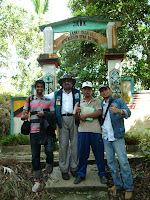



.jpg)
.jpg)

